Edie Melson's Blog, page 198
June 5, 2020
Going Through Abnormal Times as a Writer
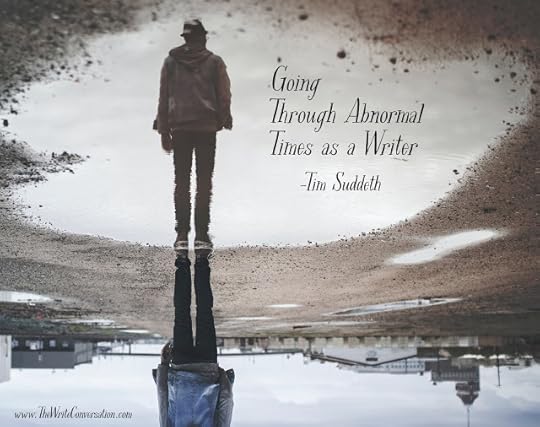
by Tim Suddeth @TimSuddeth
In the United States, most of us have been under stay at home orders since the middle of March due to the corona virus pandemic. Now, most of our states are reopening to some degree. Some are throwing their doors open so that we can return to business, others are being more cautious worried about a second wave.
And every day, there is another reason to be anxious because so many changes are happening so fast touching so much of our lives.
Dare I say we’re scared?
Yeah, I saw many of your necks bow up. Admitting to being scared would mean we would have to admit we don’t have control of our circumstances. That is when we get very uneasy, very uncomfortable. Because if we don’t have control then what do we do?
Charles Swindoll, in his book Saying It Well, recalls a chapel service whole he and his wife were attending Dallas Seminary. Dr. Dwight Pentecost was telling about the time he and his wife were in seminary. This was toward the end of the Great Depression, just before World War II. When a couple went off to college the tremendous burden of creating some semblance of a home has historically fallen to the wife. This was difficult during regular times and even worse when things were scarce.
The Pentecosts were struggling. Dr. Pentecost said that during supper one night, his wife, Dorothy, told him that she was no longer going to be discouraged. “I’ve decided that as long as we live here, while we’re preparing for ministry, we’re going to live an ‘abnormal life’.”
An abnormal life.
Chuck Swindoll wrote that those words really stuck with him. When you’re going through any type of transition, moving from one normal to another, realizing and embracing that this is abnormal can help you focus on the now. This time of pandemic, of social distancing, of quarantining, is just a transition. It’s okay to give yourself some grace as we all stumble through this unknown. Maybe cut back some on all of your doings and goals, and give yourself permission to rest and concentrate more on your current needs.
That doesn’t mean you have to give up on your goals and dreams, but now may not be the time you can give it one hundred percent.
In addition, we need to realize that others are going through abnormal times, too. I remember hearing on TV when stay-at-home was just beginning that we don’t have any instruction books for how to get through this, and we don’t have any Joneses to look to. We are all struggling figuring out how to get through this the best we can, so go easy on yourself.
This is good advice whether you’re sheltering in a pandemic, seeking to be published, starting public speaking, or going through a personal transition.
This abnormal is just for a season. (Solomon wrote something about that in Ecclesiastes.) We will either get back to normal or enter a new normal (or a combination of both).
I like the phrase I used earlier, short of God. Our omnipotent, omniscient, holy God is not anxious or afraid as He leads us forward. Like a father, leading his child through a dark room where a spider has built a web in the corner, Abba understands our childish fears. As long as we let Him hold our hand, the abnormal won’t stop us from getting where He leads.
And He might even squish that scary spider.
TWEETABLEGoing Through Abnormal Times as a Writer - @TimSuddeth on @EdieMelson (Click to Tweet)
Tim Suddeth is a stay-at-home dad and butler for his wonderful, adult son with autism. He has written numerous blogs posts, short stories, and three novels waiting for publication. He is a frequent attendee at writers’ conferences, including the Blue Ridge Mountain Christian Writers Conference and a member of Word Weavers and ACFW. He lives near Greenville, SC where he shares a house with a bossy Shorky and three too-curious Persians. You can find him on Facebook, Twitter, or at timingreenville.com.
Published on June 05, 2020 22:00
June 4, 2020
What Does it Mean to Be a Writer of Hope?
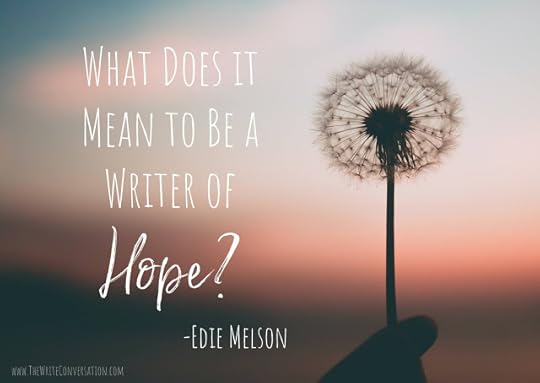
by Edie Melson @EdieMelson
Being a writer of hope is something I’m making a deliberate effort to become. Right now our world needs hope. There is so much in our world these days that can lead to hopelessness if we let it.
Because our passion (and business) is words, we have the ability to affect how others interpret the world. I’m not suggesting that we slant our viewpoint to something untrue, but rather that we take an honest look at the hope around us no matter what situation we’re viewing.
This is What Being a Writer of Hope Means to Me:
Reminding others—and ourselves—that no matter what we’re facing, we can use it to make the world better or worse.Reporting truth, but not forgetting that even the most difficult truth carries within it the seed of possibility.Remembering to be kind. We should always take time to make sure what we’re writing isn’t running others down.Remembering to be respectful. There are always two sides to every issue. Even when we disagree, we can do it without attacking one another.Repeating the fact that no situation is ever permanently bad. We all face struggles and stress, but nothing lasts forever.Redefining possibilities. Just as every situation has multiple possibilities, it’s our job as writers to bring those to light.Releasing the misconceptions we hold onto so tightly. We have to first take an honest look around us before we can share truth with others.Reinventing our own personal attitude. Unless we subscribe to the attitude of hope, it’s hard to encourage others.Reminding others of God’s ability to redeem anyone and any situation.These are the precepts I’m trying to apply to every thing I write. What would you add to the list? Be sure to leave your thoughts in the the comments section below.
Don’t forget to join the conversation!Blessings,Edie
TWEETABLESWhat does it mean to be a Writer of #Hope – thoughts from author @EdieMelson (Click to Tweet)
A writer of #hope knows that even the most difficult truth carries within it the seed of possibility (Click to Tweet)
 Edie Melson is a woman of faith with ink-stained fingers observing life through the lens of her camera. No matter whether she’s talking to writers, entrepreneurs, or readers, her first advice is always “Find your voice, live your story.” As an author, blogger, and speaker she’s encouraged and challenged audiences across the country and around the world. Her numerous books reflect her passion to help others develop the strength of their God-given gifts and apply them to their lives.Connect with her on her website, through Facebook, Twitter and on Instagram.
Edie Melson is a woman of faith with ink-stained fingers observing life through the lens of her camera. No matter whether she’s talking to writers, entrepreneurs, or readers, her first advice is always “Find your voice, live your story.” As an author, blogger, and speaker she’s encouraged and challenged audiences across the country and around the world. Her numerous books reflect her passion to help others develop the strength of their God-given gifts and apply them to their lives.Connect with her on her website, through Facebook, Twitter and on Instagram.
Published on June 04, 2020 22:00
June 3, 2020
Deadline Writing Tips in Quarantine
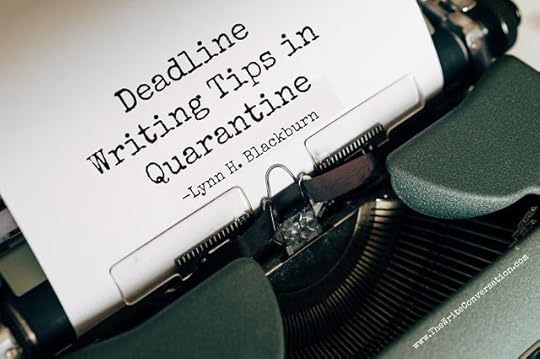
by Lynn H. Blackburn @LynnHBlackburn
I am endlessly fascinated with the way other writers write.
Are they plotters? Pantsers?
Do they write every day or are they weekend warriors?
Do they rise before dawn, or write into the wee hours of the morning?
If you’d asked me a few months ago what my writing life looked like, I would have told you the following:During the summer, I try to get a huge jump on my word count while my kids are at camp. I also typically begin new stories during the summer when I can carve out entire days to devote to the work.
Now, if you were reading closely, you may have noticed a few issues. For example, during the school year I particularly like to write away from home. Yeah. That hasn’t really happened since March. And those camps scheduled for this summer? Those aren’t happening, either.
So, maybe you’re like me and what had been working isn’t working at the moment.
Even if you live in a part of the country where things are reopening, nothing is back to “normal” and some of you are staring into a summer with things still locked down tight.
As I’ve written about before, if you have the option, please don’t beat yourself up about this. Please take care of yourself physically and emotionally.
But …
What if you’re on deadline? I get that! My deadlines don’t care that my writing routines have been demolished. They don’t care that I’m missing my table at Panera or my favorite corner of Starbucks, or the way last summer I was able to go to Java Bistro, my local coffee shop, at least once a week, order my coffee and loaded grits for breakfast and work until they closed at 2:30.
Perhaps you can relate?
If so, let me share the following tips for figuring out a way to get the work done that has to be done:
1. Spend some time thinking over what used to work and see if you can pinpoint specifically what makes it effective. Then see if there’s some way you can replicate that. In my case, I crave uninterrupted time with as few distractions as possible. So that means getting up to write early, or writing late after everyone’s gone to bed, or maybe doing something weird. See Item #2.
2. Don’t be afraid to look weird. I know, we’re all writers so we’re used to weird, but that doesn’t necessarily mean we make a habit of flaunting our strangeness. But these days, you might have to risk it. Some of the best writing I’ve had in the last few months was the day I took my laptop and parked behind a grocery store to write. I’m not making this up. There was shade, it was daylight, I was in a safe place, and I was alone. Away from the internet and away from distractions. Ironically, this location put me between my Starbucks and my library, so maybe the good writerly vibes were floating around? Who knows? The bottom line is it worked, and I really didn’t care if I looked weird.
3. Lower your expectations. Please note I didn’t say lower your quality of work. We should always seek to be effective communicators and to do our best. But guess what? I’m not expecting to hit my word count goals every day. I’m not expecting that things will go perfectly every time I sit down to write. That’s okay.
4. Consider revisiting a method that you’ve previously tried and discarded. I’m not a morning person and I’m not a fan of trying to write early, but I’ve decided to give it another try. It hasn’t worked well for me in the past, but things aren’t the way they have ever been before. Maybe this time it will work. If it doesn’t, see Number 5.
5. If at first you don’t succeed . . . I know you know the rest. It may take several tries to find something that will work. As an example, my kids are old enough to help out, so I asked them to give me some time to write last Friday and honestly, it was a disaster. But this afternoon, I told them I needed to focus and that when I was done (at a specified time) we would go get ice cream and come home and play a favorite game. Y’all. It’s working great. They are being so quiet, and I am getting tons of work done. :) I’m not above bribery, folks. You do what you gotta do! :)
Now, it’s your turn. If you’re still churning out words, or working on revisions, I’d love to know what’s working for you. How has your routine changed, and have you found new ways of getting work done? Share it with us in the comments so we can all learn from each other!
Grace and peace,

TWEETABLEDeadline Writing Tips in Quarantine - @LynnHBlackburn on @EdieMelson (Click to Tweet)
 Lynn H. Blackburn loves writing suspense because her childhood fantasy was to become a spy, but her grown-up reality is that she's a huge chicken and would have been caught on her first mission. She prefers to live vicariously through her characters and loves putting them into all kinds of terrifying situations while she's sitting at home safe and sound in her pajamas!
Lynn H. Blackburn loves writing suspense because her childhood fantasy was to become a spy, but her grown-up reality is that she's a huge chicken and would have been caught on her first mission. She prefers to live vicariously through her characters and loves putting them into all kinds of terrifying situations while she's sitting at home safe and sound in her pajamas! Her Dive Team Investigations series kicked off in 2018 with Beneath the Surface and In Too Deep (A SIBA Okra pick and Selah Award Finalist). The 3rd book in the series, One Final Breath, released September 2019 and is a 2020 Selah Award and a 2020 Faith Hope, and Love Reader’s Choice Award finalist. She is also the author of Hidden Legacy and Covert Justice, which won the 2016 Carol Award for Short Novel and the 2016 Selah Award for Mystery and Suspense. Lynn lives in South Carolina with her true love and their three children. You can follow her real life happily ever after at LynnHBlackburn.com and @LynnHBlackburn on Bookbub, Facebook, Twitter, Pinterest, and Instagram.
Published on June 03, 2020 22:00
June 2, 2020
Four Great Ways for an Author to Hook a Reader

by Sarah Sally Hamer @SarahSallyHamer
Pick a book from your reading pile and read the first line of the story. Did it "hook" you? Did it make you want to read more? Or did you put the book back down and promise yourself you'll read it later
Hooks are that important. They are really the difference between your book being read or not.So, how do we create great hooks? Here are four things to do.
1. Create a question in the reader's mind.
A hook should be provocative and immediately immerse the reader in the ongoing story question. For instance,
It was a bright cold day in April, and the clocks were striking thirteen. —George Orwell, 1984.
What questions should a reader have? What do the weather, the month, and broken clocks have to do with the story? Sounds ominous to me, as if something very much worse was going to happen.
Another one: You don't know about me without you have read a book by the name of The Adventures of Tom Sawyer; but that ain't no matter. —Mark Twain, Adventures of Huckleberry Finn.
This first line tells us a huge amount, including that the protagonist doesn't speak correct English, that he's been in another story which the reader may have read, and that he'll get on with the story, no matter what.
2. Start In media res
Or, in English, "in the middle of." Instead of miles and miles of backstory or description, we can start in the middle of something very important and immediately hook our reader. Don't worry, you can use the backstory and description later, but start with something interesting and gripping.
Mother died today. —Albert Camus, The Stranger
Can't get much more in the middle of something than that, right?
Here's another one: “It was dark where she was crouched but the little girl did as she’d been told.” --Kate Morton, The Forgotten Garden.
The foreboding, the fear hanging over her head is palpable. Would you read more?
3. Use an interesting character or description
Surprise your reader. Show them someone or someplace so intriguing they can't put the book down.
In my younger and more vulnerable years my father gave me some advice that I've been turning over in my mind ever since. —F. Scott Fitzgerald, The Great Gatsby,
This line foreshadows the character who ends up in real problems.The towers of Zenith aspired above the morning mist; austere towers of steel and cement and limestone, sturdy as cliffs and delicate as silver rods. —Sinclair Lewis, Babbitt.
Beautiful imagery!
4. Give your character a goal
The goal can be implied, but the power is in letting the reader know right away that the character will have to fight to get what he or she wants.
He was an old man who fished alone in a skiff in the Gulf Stream and he had gone eighty-four days now without taking a fish. —Ernest Hemingway, The Old Man and the Sea.
Immediately, we know that catching a fish is the main thing he wants.
Every summer Lin Kong returned to Goose Village to divorce his wife, Shuyu. —Ha Jin, Waiting.
Wow! Why does he intend to divorce her? Why doesn't he?
There are many more ways to create hooks, of course, but these will give you a good start.
A couple of words of warning: Don't think that the hook is the answer to making your book great. Everything in the book needs to be great.The hook needs to be directly connected to what happens in the book and, at least to some degree, an overview of the entire book. For instance, don't have an easily or quickly solved problem be your hook. "She thought she was going to die," sounds like a great hook but if she's not under a threat of death throughout the entire book, the reader will feel cheated.
What kind of hooks do you like? Post a favorite hook or one you're struggling with and we'll work on it!
TWEETABLEFour Great Ways for an Author to Hook a Reader - @SarahSallyHamer on @EdieMelson (Click to Tweet)
I wish to express gratitude to the giants whose shoulders I stand on and who taught me so much about the writing craft. I would list every one, if it were only possible.
 Sarah (Sally) Hamer is a lover of books, a teacher of writers, and a believer in a good story. Most of all, she is eternally fascinated by people and how they 'tick'. She’s passionate about helping people tell their own stories, whether through fiction or through memoir. Writing in many genres - mystery, science fiction, fantasy, romance, medieval history, non-fiction – she has won awards at both local and national levels, including two Golden Heart finals.
Sarah (Sally) Hamer is a lover of books, a teacher of writers, and a believer in a good story. Most of all, she is eternally fascinated by people and how they 'tick'. She’s passionate about helping people tell their own stories, whether through fiction or through memoir. Writing in many genres - mystery, science fiction, fantasy, romance, medieval history, non-fiction – she has won awards at both local and national levels, including two Golden Heart finals.A teacher of memoir, beginning and advanced creative fiction writing, and screenwriting at Louisiana State University in Shreveport for almost twenty years, she also teaches online for Margie Lawson at www.margielawson.com. Sally is a free-lance editor and book coach at Touch Not the Cat Books, with many of her students and clients becoming successful, award-winning authors.
<!-- /* Style Definitions */ p.MsoNormal, li.MsoNormal, div.MsoNormal {mso-style-unhide:no; mso-style-qformat:yes; mso-style-parent:""; margin-top:0in; margin-right:0in; margin-bottom:10.0pt; margin-left:0in; line-height:115%; mso-pagination:widow-orphan; font-size:11.0pt; font-family:Calibri; mso-ascii-font-family:Calibri; mso-ascii-theme-font:minor-latin; mso-fareast-font-family:Calibri; mso-fareast-theme-font:minor-latin; mso-hansi-font-family:Calibri; mso-hansi-theme-font:minor-latin; mso-bidi-font-family:"Times New Roman"; mso-bidi-theme-font:minor-bidi;} a:link, span.MsoHyperlink {mso-style-priority:99; color:blue; mso-themecolor:hyperlink; text-decoration:underline; text-underline:single;} a:visited, span.MsoHyperlinkFollowed {mso-style-noshow:yes; mso-style-priority:99; color:purple; mso-themecolor:followedhyperlink; text-decoration:underline; text-underline:single;} p.MsoListParagraph, li.MsoListParagraph, div.MsoListParagraph {mso-style-priority:34; mso-style-unhide:no; mso-style-qformat:yes; margin-top:0in; margin-right:0in; margin-bottom:10.0pt; margin-left:.5in; mso-add-space:auto; line-height:115%; mso-pagination:widow-orphan; font-size:11.0pt; font-family:Calibri; mso-ascii-font-family:Calibri; mso-ascii-theme-font:minor-latin; mso-fareast-font-family:Calibri; mso-fareast-theme-font:minor-latin; mso-hansi-font-family:Calibri; mso-hansi-theme-font:minor-latin; mso-bidi-font-family:"Times New Roman"; mso-bidi-theme-font:minor-bidi;} p.MsoListParagraphCxSpFirst, li.MsoListParagraphCxSpFirst, div.MsoListParagraphCxSpFirst {mso-style-priority:34; mso-style-unhide:no; mso-style-qformat:yes; mso-style-type:export-only; margin-top:0in; margin-right:0in; margin-bottom:0in; margin-left:.5in; margin-bottom:.0001pt; mso-add-space:auto; line-height:115%; mso-pagination:widow-orphan; font-size:11.0pt; font-family:Calibri; mso-ascii-font-family:Calibri; mso-ascii-theme-font:minor-latin; mso-fareast-font-family:Calibri; mso-fareast-theme-font:minor-latin; mso-hansi-font-family:Calibri; mso-hansi-theme-font:minor-latin; mso-bidi-font-family:"Times New Roman"; mso-bidi-theme-font:minor-bidi;} p.MsoListParagraphCxSpMiddle, li.MsoListParagraphCxSpMiddle, div.MsoListParagraphCxSpMiddle {mso-style-priority:34; mso-style-unhide:no; mso-style-qformat:yes; mso-style-type:export-only; margin-top:0in; margin-right:0in; margin-bottom:0in; margin-left:.5in; margin-bottom:.0001pt; mso-add-space:auto; line-height:115%; mso-pagination:widow-orphan; font-size:11.0pt; font-family:Calibri; mso-ascii-font-family:Calibri; mso-ascii-theme-font:minor-latin; mso-fareast-font-family:Calibri; mso-fareast-theme-font:minor-latin; mso-hansi-font-family:Calibri; mso-hansi-theme-font:minor-latin; mso-bidi-font-family:"Times New Roman"; mso-bidi-theme-font:minor-bidi;} p.MsoListParagraphCxSpLast, li.MsoListParagraphCxSpLast, div.MsoListParagraphCxSpLast {mso-style-priority:34; mso-style-unhide:no; mso-style-qformat:yes; mso-style-type:export-only; margin-top:0in; margin-right:0in; margin-bottom:10.0pt; margin-left:.5in; mso-add-space:auto; line-height:115%; mso-pagination:widow-orphan; font-size:11.0pt; font-family:Calibri; mso-ascii-font-family:Calibri; mso-ascii-theme-font:minor-latin; mso-fareast-font-family:Calibri; mso-fareast-theme-font:minor-latin; mso-hansi-font-family:Calibri; mso-hansi-theme-font:minor-latin; mso-bidi-font-family:"Times New Roman"; mso-bidi-theme-font:minor-bidi;} .MsoChpDefault {mso-style-type:export-only; mso-default-props:yes; font-size:11.0pt; mso-ansi-font-size:11.0pt; mso-bidi-font-size:11.0pt; font-family:Calibri; mso-ascii-font-family:Calibri; mso-ascii-theme-font:minor-latin; mso-fareast-font-family:Calibri; mso-fareast-theme-font:minor-latin; mso-hansi-font-family:Calibri; mso-hansi-theme-font:minor-latin; mso-bidi-font-family:"Times New Roman"; mso-bidi-theme-font:minor-bidi;} .MsoPapDefault {mso-style-type:export-only; margin-bottom:10.0pt; line-height:115%;} @page WordSection1 {size:8.5in 11.0in; margin:1.0in 1.0in 1.0in 1.0in; mso-header-margin:.5in; mso-footer-margin:.5in; mso-paper-source:0;} div.WordSection1 {page:WordSection1;} /* List Definitions */ @list l0 {mso-list-id:680204117; mso-list-type:hybrid; mso-list-template-ids:-61318448 67698703 67698713 67698715 67698703 67698713 67698715 67698703 67698713 67698715;} @list l0:level1 {mso-level-tab-stop:none; mso-level-number-position:left; text-indent:-.25in;} @list l0:level2 {mso-level-number-format:alpha-lower; mso-level-tab-stop:none; mso-level-number-position:left; text-indent:-.25in;} @list l0:level3 {mso-level-number-format:roman-lower; mso-level-tab-stop:none; mso-level-number-position:right; text-indent:-9.0pt;} @list l0:level4 {mso-level-tab-stop:none; mso-level-number-position:left; text-indent:-.25in;} @list l0:level5 {mso-level-number-format:alpha-lower; mso-level-tab-stop:none; mso-level-number-position:left; text-indent:-.25in;} @list l0:level6 {mso-level-number-format:roman-lower; mso-level-tab-stop:none; mso-level-number-position:right; text-indent:-9.0pt;} @list l0:level7 {mso-level-tab-stop:none; mso-level-number-position:left; text-indent:-.25in;} @list l0:level8 {mso-level-number-format:alpha-lower; mso-level-tab-stop:none; mso-level-number-position:left; text-indent:-.25in;} @list l0:level9 {mso-level-number-format:roman-lower; mso-level-tab-stop:none; mso-level-number-position:right; text-indent:-9.0pt;} </style></div>--><br /><div class="MsoNormal" style="background-color: white; line-height: normal; margin-bottom: 0.0001pt; text-align: left;"><span style="font-family: "verdana" , sans-serif;"><span style="font-size: 12pt;">You can find her at </span><span style="font-size: 12pt;">hamerse@bellsouth.net</span><span style="font-size: 12pt;"> or </span><span style="font-size: 12pt;"><a href="http://www.sallyhamer.blogspot.com/&q... style="font-family: "times"; font-size: 12pt;"><o:p></o:p></span></div>
Published on June 02, 2020 22:00
Four Great Ways fro an Author to Hook a Reader

by Sarah Sally Hamer @SarahSallyHamer
Pick a book from your reading pile and read the first line of the story. Did it "hook" you? Did it make you want to read more? Or did you put the book back down and promise yourself you'll read it later
Hooks are that important. They are really the difference between your book being read or not.So, how do we create great hooks? Here are four things to do.
1. Create a question in the reader's mind.
A hook should be provocative and immediately immerse the reader in the ongoing story question. For instance,
It was a bright cold day in April, and the clocks were striking thirteen. —George Orwell, 1984.
What questions should a reader have? What do the weather, the month, and broken clocks have to do with the story? Sounds ominous to me, as if something very much worse was going to happen.
Another one: You don't know about me without you have read a book by the name of The Adventures of Tom Sawyer; but that ain't no matter. —Mark Twain, Adventures of Huckleberry Finn.
This first line tells us a huge amount, including that the protagonist doesn't speak correct English, that he's been in another story which the reader may have read, and that he'll get on with the story, no matter what.
2. Start In media res
Or, in English, "in the middle of." Instead of miles and miles of backstory or description, we can start in the middle of something very important and immediately hook our reader. Don't worry, you can use the backstory and description later, but start with something interesting and gripping.
Mother died today. —Albert Camus, The Stranger
Can't get much more in the middle of something than that, right?
Here's another one: “It was dark where she was crouched but the little girl did as she’d been told.” --Kate Morton, The Forgotten Garden.
The foreboding, the fear hanging over her head is palpable. Would you read more?
3. Use an interesting character or description
Surprise your reader. Show them someone or someplace so intriguing they can't put the book down.
In my younger and more vulnerable years my father gave me some advice that I've been turning over in my mind ever since. —F. Scott Fitzgerald, The Great Gatsby,
This line foreshadows the character who ends up in real problems.The towers of Zenith aspired above the morning mist; austere towers of steel and cement and limestone, sturdy as cliffs and delicate as silver rods. —Sinclair Lewis, Babbitt.
Beautiful imagery!
4. Give your character a goal
The goal can be implied, but the power is in letting the reader know right away that the character will have to fight to get what he or she wants.
He was an old man who fished alone in a skiff in the Gulf Stream and he had gone eighty-four days now without taking a fish. —Ernest Hemingway, The Old Man and the Sea.
Immediately, we know that catching a fish is the main thing he wants.
Every summer Lin Kong returned to Goose Village to divorce his wife, Shuyu. —Ha Jin, Waiting.
Wow! Why does he intend to divorce her? Why doesn't he?
There are many more ways to create hooks, of course, but these will give you a good start.
A couple of words of warning: Don't think that the hook is the answer to making your book great. Everything in the book needs to be great.The hook needs to be directly connected to what happens in the book and, at least to some degree, an overview of the entire book. For instance, don't have an easily or quickly solved problem be your hook. "She thought she was going to die," sounds like a great hook but if she's not under a threat of death throughout the entire book, the reader will feel cheated.
What kind of hooks do you like? Post a favorite hook or one you're struggling with and we'll work on it!
TWEETABLEFour Great Ways for an Author to Hook a Reader - @SarahSallyHamer on @EdieMelson (Click to Tweet)
I wish to express gratitude to the giants whose shoulders I stand on and who taught me so much about the writing craft. I would list every one, if it were only possible.
 Sarah (Sally) Hamer is a lover of books, a teacher of writers, and a believer in a good story. Most of all, she is eternally fascinated by people and how they 'tick'. She’s passionate about helping people tell their own stories, whether through fiction or through memoir. Writing in many genres - mystery, science fiction, fantasy, romance, medieval history, non-fiction – she has won awards at both local and national levels, including two Golden Heart finals.
Sarah (Sally) Hamer is a lover of books, a teacher of writers, and a believer in a good story. Most of all, she is eternally fascinated by people and how they 'tick'. She’s passionate about helping people tell their own stories, whether through fiction or through memoir. Writing in many genres - mystery, science fiction, fantasy, romance, medieval history, non-fiction – she has won awards at both local and national levels, including two Golden Heart finals.A teacher of memoir, beginning and advanced creative fiction writing, and screenwriting at Louisiana State University in Shreveport for almost twenty years, she also teaches online for Margie Lawson at www.margielawson.com. Sally is a free-lance editor and book coach at Touch Not the Cat Books, with many of her students and clients becoming successful, award-winning authors.
<!-- /* Style Definitions */ p.MsoNormal, li.MsoNormal, div.MsoNormal {mso-style-unhide:no; mso-style-qformat:yes; mso-style-parent:""; margin-top:0in; margin-right:0in; margin-bottom:10.0pt; margin-left:0in; line-height:115%; mso-pagination:widow-orphan; font-size:11.0pt; font-family:Calibri; mso-ascii-font-family:Calibri; mso-ascii-theme-font:minor-latin; mso-fareast-font-family:Calibri; mso-fareast-theme-font:minor-latin; mso-hansi-font-family:Calibri; mso-hansi-theme-font:minor-latin; mso-bidi-font-family:"Times New Roman"; mso-bidi-theme-font:minor-bidi;} a:link, span.MsoHyperlink {mso-style-priority:99; color:blue; mso-themecolor:hyperlink; text-decoration:underline; text-underline:single;} a:visited, span.MsoHyperlinkFollowed {mso-style-noshow:yes; mso-style-priority:99; color:purple; mso-themecolor:followedhyperlink; text-decoration:underline; text-underline:single;} p.MsoListParagraph, li.MsoListParagraph, div.MsoListParagraph {mso-style-priority:34; mso-style-unhide:no; mso-style-qformat:yes; margin-top:0in; margin-right:0in; margin-bottom:10.0pt; margin-left:.5in; mso-add-space:auto; line-height:115%; mso-pagination:widow-orphan; font-size:11.0pt; font-family:Calibri; mso-ascii-font-family:Calibri; mso-ascii-theme-font:minor-latin; mso-fareast-font-family:Calibri; mso-fareast-theme-font:minor-latin; mso-hansi-font-family:Calibri; mso-hansi-theme-font:minor-latin; mso-bidi-font-family:"Times New Roman"; mso-bidi-theme-font:minor-bidi;} p.MsoListParagraphCxSpFirst, li.MsoListParagraphCxSpFirst, div.MsoListParagraphCxSpFirst {mso-style-priority:34; mso-style-unhide:no; mso-style-qformat:yes; mso-style-type:export-only; margin-top:0in; margin-right:0in; margin-bottom:0in; margin-left:.5in; margin-bottom:.0001pt; mso-add-space:auto; line-height:115%; mso-pagination:widow-orphan; font-size:11.0pt; font-family:Calibri; mso-ascii-font-family:Calibri; mso-ascii-theme-font:minor-latin; mso-fareast-font-family:Calibri; mso-fareast-theme-font:minor-latin; mso-hansi-font-family:Calibri; mso-hansi-theme-font:minor-latin; mso-bidi-font-family:"Times New Roman"; mso-bidi-theme-font:minor-bidi;} p.MsoListParagraphCxSpMiddle, li.MsoListParagraphCxSpMiddle, div.MsoListParagraphCxSpMiddle {mso-style-priority:34; mso-style-unhide:no; mso-style-qformat:yes; mso-style-type:export-only; margin-top:0in; margin-right:0in; margin-bottom:0in; margin-left:.5in; margin-bottom:.0001pt; mso-add-space:auto; line-height:115%; mso-pagination:widow-orphan; font-size:11.0pt; font-family:Calibri; mso-ascii-font-family:Calibri; mso-ascii-theme-font:minor-latin; mso-fareast-font-family:Calibri; mso-fareast-theme-font:minor-latin; mso-hansi-font-family:Calibri; mso-hansi-theme-font:minor-latin; mso-bidi-font-family:"Times New Roman"; mso-bidi-theme-font:minor-bidi;} p.MsoListParagraphCxSpLast, li.MsoListParagraphCxSpLast, div.MsoListParagraphCxSpLast {mso-style-priority:34; mso-style-unhide:no; mso-style-qformat:yes; mso-style-type:export-only; margin-top:0in; margin-right:0in; margin-bottom:10.0pt; margin-left:.5in; mso-add-space:auto; line-height:115%; mso-pagination:widow-orphan; font-size:11.0pt; font-family:Calibri; mso-ascii-font-family:Calibri; mso-ascii-theme-font:minor-latin; mso-fareast-font-family:Calibri; mso-fareast-theme-font:minor-latin; mso-hansi-font-family:Calibri; mso-hansi-theme-font:minor-latin; mso-bidi-font-family:"Times New Roman"; mso-bidi-theme-font:minor-bidi;} .MsoChpDefault {mso-style-type:export-only; mso-default-props:yes; font-size:11.0pt; mso-ansi-font-size:11.0pt; mso-bidi-font-size:11.0pt; font-family:Calibri; mso-ascii-font-family:Calibri; mso-ascii-theme-font:minor-latin; mso-fareast-font-family:Calibri; mso-fareast-theme-font:minor-latin; mso-hansi-font-family:Calibri; mso-hansi-theme-font:minor-latin; mso-bidi-font-family:"Times New Roman"; mso-bidi-theme-font:minor-bidi;} .MsoPapDefault {mso-style-type:export-only; margin-bottom:10.0pt; line-height:115%;} @page WordSection1 {size:8.5in 11.0in; margin:1.0in 1.0in 1.0in 1.0in; mso-header-margin:.5in; mso-footer-margin:.5in; mso-paper-source:0;} div.WordSection1 {page:WordSection1;} /* List Definitions */ @list l0 {mso-list-id:680204117; mso-list-type:hybrid; mso-list-template-ids:-61318448 67698703 67698713 67698715 67698703 67698713 67698715 67698703 67698713 67698715;} @list l0:level1 {mso-level-tab-stop:none; mso-level-number-position:left; text-indent:-.25in;} @list l0:level2 {mso-level-number-format:alpha-lower; mso-level-tab-stop:none; mso-level-number-position:left; text-indent:-.25in;} @list l0:level3 {mso-level-number-format:roman-lower; mso-level-tab-stop:none; mso-level-number-position:right; text-indent:-9.0pt;} @list l0:level4 {mso-level-tab-stop:none; mso-level-number-position:left; text-indent:-.25in;} @list l0:level5 {mso-level-number-format:alpha-lower; mso-level-tab-stop:none; mso-level-number-position:left; text-indent:-.25in;} @list l0:level6 {mso-level-number-format:roman-lower; mso-level-tab-stop:none; mso-level-number-position:right; text-indent:-9.0pt;} @list l0:level7 {mso-level-tab-stop:none; mso-level-number-position:left; text-indent:-.25in;} @list l0:level8 {mso-level-number-format:alpha-lower; mso-level-tab-stop:none; mso-level-number-position:left; text-indent:-.25in;} @list l0:level9 {mso-level-number-format:roman-lower; mso-level-tab-stop:none; mso-level-number-position:right; text-indent:-9.0pt;} </style></div>--><br /><div class="MsoNormal" style="background-color: white; line-height: normal; margin-bottom: 0.0001pt; text-align: left;"><span style="font-family: "verdana" , sans-serif;"><span style="font-size: 12pt;">You can find her at </span><span style="font-size: 12pt;">hamerse@bellsouth.net</span><span style="font-size: 12pt;"> or </span><span style="font-size: 12pt;"><a href="http://www.sallyhamer.blogspot.com/&q... style="font-family: "times"; font-size: 12pt;"><o:p></o:p></span></div>
Published on June 02, 2020 22:00
June 1, 2020
To Market to Market to Sell A Fat Book
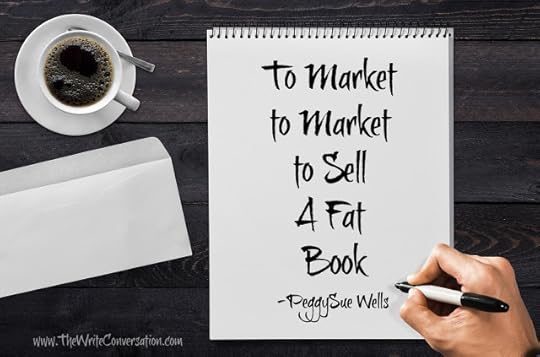
by PeggySue Wells @PeggySueWells
“I sat around for six months after book publication waiting on my publisher to do more. I assumed they would. They didn’t,” said Jennifer Maggio, author of Overwhelmed. “I learned that all of my book’s success rests on my shoulders and I better get busy doing something. Something is always better than nothing.”
In a day when book sales are predominantly the author’s responsibility, what are authors doing to market their titles?“Our grandparents purchased what they needed to live from the people they trusted,” said Christy award-winner DiAnn Mills. “Readers want a relationship with the author before buying. First care about the reader, and that manifests in social media.”
DiAnn has a website and facebook fan page. Each Monday, she posts an interactive comment or question.
Do not expect your family and friends to buy your book. Because they are family and friends, they expect you to give them a copy. Autographed.
Authors agreed on these three steps:Begin marketing immediately. Do not wait for your book to be on bookshelves. It may never get there. Don’t be shy. Ask everyone to help support you including friends, family, church members, co-workers, the guy in the grocery store.Develop a social media campaign.Be passionate.
“Don’t market to other authors,” said Linda Goldfarb, author of the Linked personality series. “They are not your audience. Market to the readers who needs what’s in your book.”
“I am part of every site I can find,” Jennifer said. “Why not? Develop a profile, put out key information and a bio, and link to your other sites. I have various support from fans in social media venues that I may never have met otherwise. Profile development on various sites is time-consuming, but it helps sell books.”
Jennifer has authored a half dozen books. “There were times when the books were not selling, and I was certain I should just go back into a corporate job. But, deep within, I knew that my story, all of the hurt from my past, was destined to inspire others. My sole purpose is to bring others redemptive hope and that motivates me. I believe that passion is what has made me successful.”
TWEETABLETo Market to Market to Sell a Fat Book - @PeggySueWells on @EdieMelson (Click to Tweet)
 Tropical island votary and history buff, PeggySue Wells parasails, skydives, snorkels, scuba dives, and has taken (but not passed) pilot training. Writing from the 100-Acre wood in Indiana, Wells is the bestselling author of twenty-eight books including The Slave Across the Street, Slavery in the Land of the Free, Bonding With Your Child Through Boundaries, Homeless for the Holidays, and Chasing Sunrise. Optimistic dream-driver, PeggySue is named for the Buddy Holly song with the great drumbeat. At school author visits, she teaches students the secrets to writing, and speaks at events and conferences. Connect with her at www.PeggySueWells.com, on Facebook at PeggySue Wells, and Twitter @PeggySueWells.
Tropical island votary and history buff, PeggySue Wells parasails, skydives, snorkels, scuba dives, and has taken (but not passed) pilot training. Writing from the 100-Acre wood in Indiana, Wells is the bestselling author of twenty-eight books including The Slave Across the Street, Slavery in the Land of the Free, Bonding With Your Child Through Boundaries, Homeless for the Holidays, and Chasing Sunrise. Optimistic dream-driver, PeggySue is named for the Buddy Holly song with the great drumbeat. At school author visits, she teaches students the secrets to writing, and speaks at events and conferences. Connect with her at www.PeggySueWells.com, on Facebook at PeggySue Wells, and Twitter @PeggySueWells.
Published on June 01, 2020 22:00
May 31, 2020
5 Ways Writers can Take Advantage of this Time—Opportunities in Corona Virus Chaos
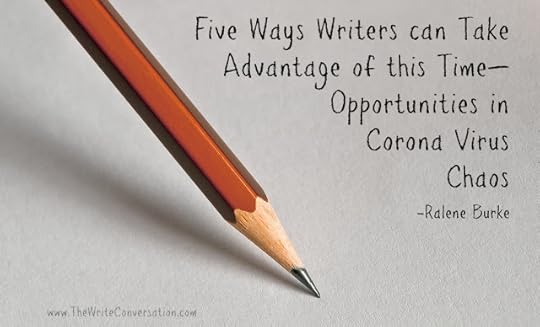
by Ralene Burke @RaleneB
For the last 10 weeks, many of us have been cooped up in our homes with our families 24/7. In some ways, the changes have been a blessing, allowing us more time with our families, showing us where are priorities should be, etc. In other ways, the changes have tested us, forcing us to learn new technology to work/school from home, keeping us from our friends and other fun activities, hampering our creative juices when everything just seems too much.Sometimes it's just hard to see the silver lining, how this could all be part of God’s plan.
And those are questions we may never have the answers to this side of Heaven. However, there are different and/or new opportunities for writers like us! Opportunities we should embrace with an open mind.
Here are just a few examples:1. We might have more TIME to write. Granted, that writing time may not seem ideal. Sometimes, we might be struggling with our creativity in general, so writing might seem too difficult. But we should be opening our creativity to different ways to grow within our writing. Maybe we aren’t working on our WIP, but we could be journaling, trying our hand at writing exercises, blogging, writing other things (like articles, devotions, etc.).2. We might have more TIME to read. Who doesn’t love curling up on the couch with a good book? Many people need an escape into fiction to help them process everything going on around us. Others might find encouragement in non-fiction and Bible study. Most people need a bit of both right now!3. We might have time to discover NEW WAYS to inspire our creativity. We can take up new hobbies, explore different art forms, develop a new skill, visit new places online…the opportunities here are endless!4. Many writers conferences have had to cancel their 2020 conferences. Others have taken their conferences ONLINE!Realm Makers, the conference for speculative fiction writers that I work for, is embarking on their first virtual experience. And with that new experience comes new registration prices and new opportunities as well!5. Since Realm Makers is happening online now, we’re learning new apps, tools, and technology to make this conference a success. Realm Makers is using a combination of Discord (a real-time chat program), CrowdCast (webinar platform for workshops), and Zoom (for one-on-one meetings). And this idea applies to writers as well—we can take this time to learn new programs that we’ve wanted to try: Scrivener, email marketing programs, organization apps, etc.
Though finding energy and focus during this time may be hard, we shouldn’t let all the opportunities pass us by. We may not be able to do ALL the things listed above, but we should try our hand at a few and see where we end up!
What new opportunities have you taken advantage of over the last couple of months? What do you hope to do in the next couple of months?
TWEETABLE5 Ways Writers can Take Advantage of this Time—Opportunities in Corona Virus Chaos via @RaleneB on @EdieMelson (Click to Tweet)
 Whether she’s wielding a fantasy writer’s pen, a social media wand, or a freelance editor’s sword, Ralene Burke always has her head in some dreamer’s world. And her goal is to help everyone #SHINE Beyond their circumstances! Her novels, Bellanok and Armor of Aletheia, are available on Amazon. More fantasy novels coming soon!
Whether she’s wielding a fantasy writer’s pen, a social media wand, or a freelance editor’s sword, Ralene Burke always has her head in some dreamer’s world. And her goal is to help everyone #SHINE Beyond their circumstances! Her novels, Bellanok and Armor of Aletheia, are available on Amazon. More fantasy novels coming soon!When her head’s not in the publishing world, she is wife to a veteran and homeschooling mama to their three kids. Her Pinterest board would have you believe she is a master chef, excellent seamstress, and all-around crafty diva. If she only had the time . . . You can also find her on Facebook, Instagram, Twitter, or at her website.
Published on May 31, 2020 22:00
May 30, 2020
Using Seeds of Failure to Grow Fruit
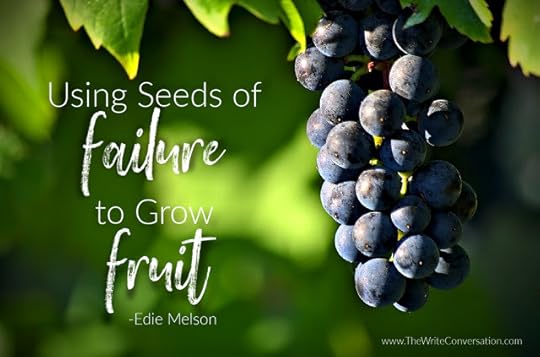
by Edie Melson @EdieMelson
But the fruit of the Spirit is love, joy, peace, patience, kindness, goodness, faithfulness, gentleness, self-control… Galatians 5:22-23
I travel around the country speaking and teaching at writers conferences. Beyond being about to help other follow their dreams, I also get to hear about other authors’ journeys to publication.
In the past I would have called them failures.
As I've heard more and more stories, I've reflected on those instances in my life that I've always labeled as failures and shortcomings. Now, in the light of the successes those detours had brought, I see them more clearly. They're really been valuable opportunities to grow and learn.Those times of waiting had become patience.The weeks—and sometimes months of—frustration had become discipline.The heart-breaking rejections became joy.All those difficult circumstances had been used by God to teach me things I lacked, as well as giving me compassion for others on similar journeys.
Somewhere along the way, God used the seeds of failure to grow fruit in my life.
Today I challenge you to look at those things you’ve labeled failure, and notice the fruit that’s now begun to grow.
TWEETABLE
Using Seeds of Failure to Grow Fruit - @EdieMelson (Click to Tweet)
 Edie Melson is a woman of faith with ink-stained fingers observing life through the lens of her camera. No matter whether she’s talking to writers, entrepreneurs, or readers, her first advice is always “Find your voice, live your story.” As an author, blogger, and speaker she’s encouraged and challenged audiences across the country and around the world. Her numerous books reflect her passion to help others develop the strength of their God-given gifts and apply them to their lives.Connect with her on her website, through Facebook, Twitter and on Instagram.
Edie Melson is a woman of faith with ink-stained fingers observing life through the lens of her camera. No matter whether she’s talking to writers, entrepreneurs, or readers, her first advice is always “Find your voice, live your story.” As an author, blogger, and speaker she’s encouraged and challenged audiences across the country and around the world. Her numerous books reflect her passion to help others develop the strength of their God-given gifts and apply them to their lives.Connect with her on her website, through Facebook, Twitter and on Instagram.
Published on May 30, 2020 22:00
May 29, 2020
What Does My Writing Reflect?
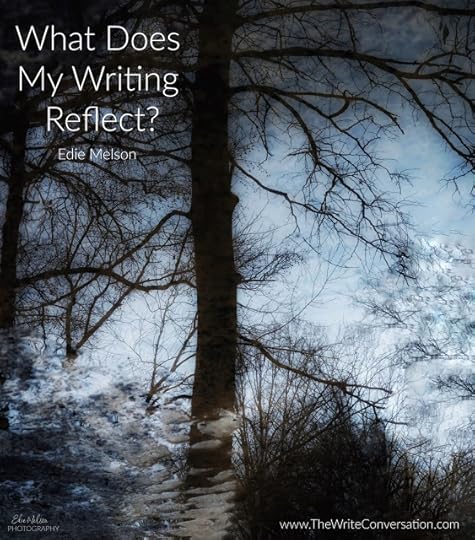
by Edie Melson @EdieMelson
It’s no surprise—to anyone who follows my photography regularly—that I love reflections. My husband, Kirk, claims it’s not possible for me to pass a puddle without snapping a picture (I plead the 5th). But his observation has made me consider why I’m so enamored by these unexpected photo ops.
Reflections are unexpected glimpses of something obvious. To me, they’re almost more revelations than reflections.
And this is the crux of what it means to be a writer—an exceptional writer. We look at situations, characters, and even God and we share something unexpected. We freeze the moments of life and give those who read our words an opportunity to look at things from a different perspective.
So as I dive back into my writing, I’m going to consider what it's reflecting. Do I take the time and effort to mirror the joy, hope and love of Jesus in unexpected ways through what I write? Or when people read my words do they see only what's expected?
And I'm going to take this lesson and apply it to my life at large. Because I'm learning that when I reflect on the obvious, I often find God reveals something unexpected.
Where has reflecting led you recently in your writing? Be sure to leave your thoughts in the comments section below!
Don't forget to join the conversation!Blessings,Edie
TWEETABLEWhat Does My Writing Reflect? - @EdieMelson (Click to Tweet)
 Edie Melson is a woman of faith with ink-stained fingers observing life through the lens of her camera. No matter whether she’s talking to writers, entrepreneurs, or readers, her first advice is always “Find your voice, live your story.” As an author, blogger, and speaker she’s encouraged and challenged audiences across the country and around the world. Her numerous books reflect her passion to help others develop the strength of their God-given gifts and apply them to their lives.Connect with her on her website, through Facebook, Twitter and on Instagram.
Edie Melson is a woman of faith with ink-stained fingers observing life through the lens of her camera. No matter whether she’s talking to writers, entrepreneurs, or readers, her first advice is always “Find your voice, live your story.” As an author, blogger, and speaker she’s encouraged and challenged audiences across the country and around the world. Her numerous books reflect her passion to help others develop the strength of their God-given gifts and apply them to their lives.Connect with her on her website, through Facebook, Twitter and on Instagram.
Published on May 29, 2020 22:00
May 28, 2020
Make Your Writing Life Easier with These 12 Hacks
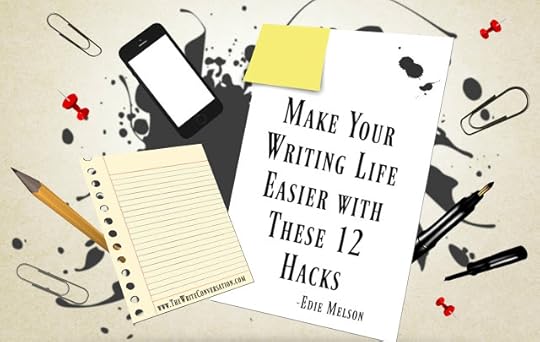
by Edie Melson @EdieMelson
The writer’s life isn’t an easy one. So much of what we create comes from some place deep inside ourselves. Giving that way can be exhausting, not to mention frustrating, when we feel empty.
The good news is that there are things we can do to help ourselves. I’ve come to learn that we either set ourselves up for success or we set ourselves up for failure. Today I’ll share some of the writing and blogging hacks that every successful writer needs to know.
1. Writing is a mind game—and our minds play tricks on us. When we’re in a good mood, we have confidence. When something goes wrong, that confidence melts away. Successful writers don’t base their confidence on emotions.
2. Speak kindly to yourself. Along with the attitude comes the way we treat ourselves. We talk junk to ourselves in ways that we would never talk to someone else. Decide right now to stop. Speak words of encouragement to yourself and you’ll speed the path to success.
3. Take care of yourself physically. Writing isn’t just hard because of the mind games. It’s hard on our bodies. Just sitting all day has shown to cause horrible health problems. Take time to get the exercise you need and fuel your body with healthy food and plenty of water.
4. Schedule some rest and relaxation. I’m not necessarily talking about napping, although that's not a bad idea. Writing regularly is important, but so is time away. Take a drive, plan lunch out with a friend, what ever helps you relax.
5. Follow a regular writing schedule. Notice I said regular—not normal. You may only be able to write late at night, or early in the morning. Or you may only be able to write on the weekends. Whatever works for you is fine—as long as you do it regularly.
6. Surround yourself with other writers who have the same commitment. This is so important. If you surround yourself with others who aren’t serious about writing or those you constantly have to shore up and encourage, you’ll wear yourself out. Find people who are committed to finish well, no matter what life problems crop up.
7. Set goals that you can track and measure. If you can’t tell how close you are to a goal, it’s pretty frustrating, so make sure the goals you have are ones where you can track the progress. For example, set a goal to send out so many queries or proposals or attend so many conferences. Don’t make getting a publishing contract the goal. You really don’t have any control over a publisher saying yes or no. BUT you can write the book, send out the queries and get everything in place for when it does happen.
8. Invest in your dream. You have the right to follow your heart. Don’t let anyone say you don’t. But also don’t be your own worst enemy. Invest time, effort and money in making your publishing goals a reality.
9. Learn how to take critique. Writers seem to range from one extreme to the other. We either think everything we write is perfect and better than anything out there. Or we think everything we write is junk. We have no perspective. Find others you respect and listen to what they have to say about your writing. Improve where you need to, and relish the parts that truly are great.
10. Read regularly. I know that none of us has the time, but successful writers (those who are growing in their craft) know it’s vital to take the time. Read regularly, read deeply and read widely.
11. Never go anywhere without a notebook. That notebook might be a note-taking app on your mobile device, but never be without a way to record idea. Inspiration ALWAYS strikes at inconvenient times. Don’t get caught without a way to capture an illusive idea.
12. Keep writing, no matter what. Yes, life happens. But no matter what rough time you’re going through keep writing. You might be able to put away the formal projects when a crisis hits, but keep writing something—a journal, a poem, a prayer.
These are the things that help me keep moving forward, no matter what. I’d love for you to add to the list.
Don’t forget to join the conversation!Blessings,Edie
TWEETABLESMake Your Writing Life Easier with These 12 Hacks - @EdieMelson (Click to Tweet)
 Edie Melson is a woman of faith with ink-stained fingers observing life through the lens of her camera. No matter whether she’s talking to writers, entrepreneurs, or readers, her first advice is always “Find your voice, live your story.” As an author, blogger, and speaker she’s encouraged and challenged audiences across the country and around the world. Her numerous books reflect her passion to help others develop the strength of their God-given gifts and apply them to their lives.Connect with her on her website, through Facebook, Twitter and on Instagram.
Edie Melson is a woman of faith with ink-stained fingers observing life through the lens of her camera. No matter whether she’s talking to writers, entrepreneurs, or readers, her first advice is always “Find your voice, live your story.” As an author, blogger, and speaker she’s encouraged and challenged audiences across the country and around the world. Her numerous books reflect her passion to help others develop the strength of their God-given gifts and apply them to their lives.Connect with her on her website, through Facebook, Twitter and on Instagram.
Published on May 28, 2020 22:00



